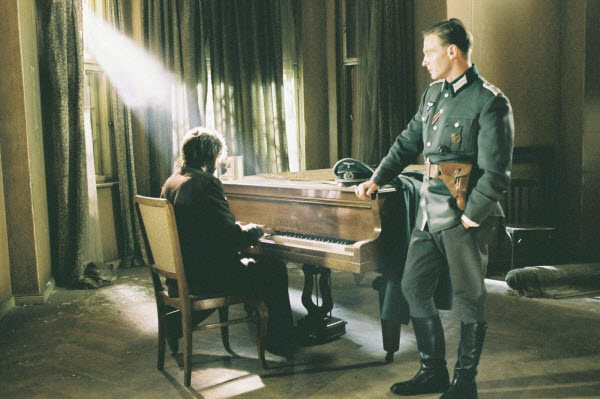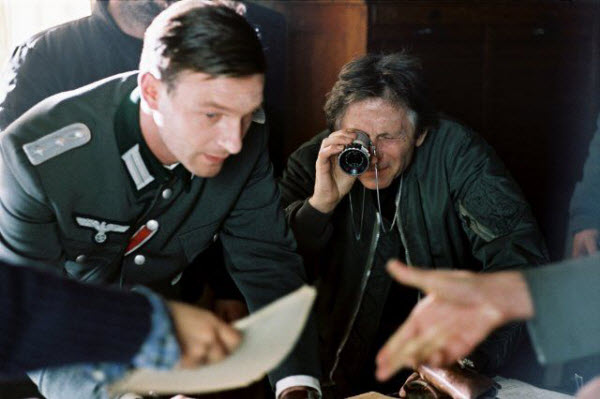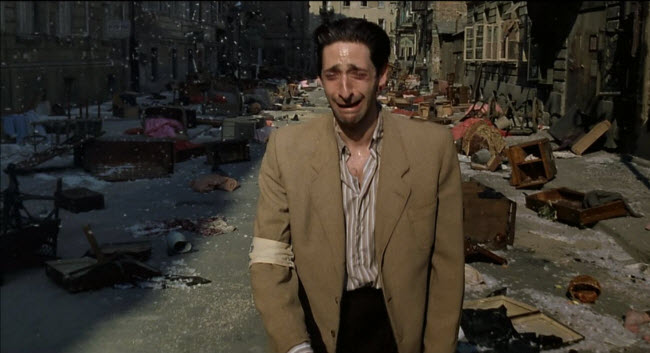The Pianist, directed by Roman Polanski, is a 2002 film that stands as a profound portrayal of survival during the Holocaust. Based on the autobiography of Władysław Szpilman, a Polish-Jewish pianist, the film offers a harrowing yet compelling glimpse into the horrors of World War II through the eyes of a gifted artist. Polanski, himself a Holocaust survivor, brings an authenticity and emotional depth to the narrative, making The Pianist a critically acclaimed masterpiece that won several prestigious awards, including three Academy Awards.

Plot Summary (Warning: Spoilers Ahead)
The Pianist begins in 1939, following Władysław Szpilman (Adrien Brody), a talented pianist whose life is upended by the Nazi invasion of Poland. As the Nazis occupy Warsaw, Szpilman and his family are forced into the Warsaw Ghetto, where they endure severe hardships. Szpilman’s family is eventually deported, but he manages to evade capture by hiding in various locations throughout the city.
Szpilman’s journey through the ruins of Warsaw is depicted with stark realism. He experiences extreme deprivation, encounters various people who both help and hinder him, and witnesses the widespread devastation of the city. One of the pivotal moments in the film is Szpilman’s encounter with a German officer, Captain Wilm Hosenfeld (Thomas Kretschmann), who provides him with aid and ultimately plays a crucial role in his survival. The film concludes with Szpilman’s liberation by Soviet forces in 1945, reflecting on his arduous journey and the profound impact of the war on his life.
Main Characters and Actors
- Władysław Szpilman (Adrien Brody): The protagonist, whose portrayal by Brody won him the Academy Award for Best Actor. Brody’s performance is marked by intense emotional depth and authenticity.
- Captain Wilm Hosenfeld (Thomas Kretschmann): A German officer who, despite his role in the enemy forces, provides crucial assistance to Szpilman.
- The Szpilman Family (Various actors): Includes Szpilman’s father, mother, and siblings, whose fates are depicted with poignancy and respect.
- Dorota (Emilia Fox): A character who briefly appears and provides emotional support to Szpilman during his time in hiding.
Awards and Recognition
The Pianist received widespread acclaim and numerous awards, including:
- Academy Awards: Best Director (Roman Polanski), Best Actor (Adrien Brody), and Best Adapted Screenplay (Ronald Harwood).
- Cannes Film Festival: Best Director award for Polanski.
- Golden Globe Awards: Best Motion Picture – Drama, Best Director, and Best Actor – Drama.
Trivia (100 Interesting Facts)

- Polanski’s Personal Experience: Roman Polanski was a Holocaust survivor, which profoundly influenced his direction of the film.
- Adrien Brody’s Transformation: Brody lost 30 pounds to authentically portray Szpilman’s physical deterioration due to starvation.
- Historical Accuracy: The film is noted for its adherence to Szpilman’s true-life experiences and the historical events of the Holocaust.
- Real Locations: Many scenes were filmed on location in Warsaw, enhancing the film’s realism.
- Wojciech Kilar’s Score: The film’s music, composed by Wojciech Kilar, adds significant emotional depth and authenticity.
- Polanski’s Cameo: Roman Polanski appears briefly in the film as a Jewish pianist.
- Brody’s Piano Skills: Adrien Brody underwent extensive piano training to convincingly portray Szpilman’s musical talent.
- Set Design: The film’s set design meticulously recreated the Warsaw Ghetto and other locations to reflect historical accuracy.
- Cinematic Techniques: Polanski used long takes and minimal dialogue to heighten the sense of isolation and suffering.
- Authentic Props: Many props, including furniture and clothing, were sourced to ensure historical accuracy.
- Critical Acclaim: The Pianist holds a high rating on Rotten Tomatoes, reflecting its critical success.
- Real Diary: Szpilman’s autobiography provided the source material for the film’s screenplay.
- Brody’s Performance: Adrien Brody’s portrayal was praised for its emotional intensity and realism.
- Historical References: The film includes accurate depictions of wartime events and conditions in the Warsaw Ghetto.
- Method Acting: Brody’s method acting involved immersing himself in Szpilman’s life experiences.
- Emotional Impact: The film’s emotional impact is amplified by its realistic portrayal of Szpilman’s experiences.
- Filming Locations: The film’s use of actual Warsaw locations added authenticity to the depiction of Szpilman’s journey.
- Polanski’s Direction: Polanski’s direction emphasizes the personal and emotional aspects of Szpilman’s story.
- Role of Music: The music score plays a crucial role in conveying the film’s emotional and thematic depth.
- Historical Context: The film’s release was timely, given the ongoing global interest in Holocaust narratives.
- Awards: The Pianist won three Academy Awards and several other accolades for its direction, acting, and screenplay.
- Brody’s Transformation: The physical transformation of Adrien Brody was a significant aspect of his performance.
- Film’s Length: The film’s runtime allows for an in-depth exploration of Szpilman’s experiences.
- Survivor’s Story: The film is one of many cinematic works that highlight the experiences of Holocaust survivors.
- Portrayal of Suffering: The film’s portrayal of suffering is both harrowing and deeply moving.
- Character Depth: The characters in the film are depicted with considerable depth and nuance.
- Polanski’s Influence: Polanski’s personal history as a Holocaust survivor influenced his approach to the film.
- Realism in Filming: The film’s realistic portrayal of the Warsaw Ghetto was achieved through careful research and attention to detail.
- Performance Recognition: Adrien Brody’s performance earned widespread recognition and numerous awards.
- Film’s Impact: The film has had a lasting impact on the portrayal of Holocaust narratives in cinema.
- Historical Setting: The film’s setting is meticulously recreated to reflect the period accurately.
- Casting Choices: The casting of Adrien Brody was a key factor in the film’s success.
- Survivor’s Perspective: The film provides a unique perspective on the Holocaust through Szpilman’s story.
- Cinematic Techniques: The use of cinematic techniques enhances the film’s emotional and narrative impact.
- Polanski’s Vision: Polanski’s vision for the film was to create a powerful and authentic portrayal of Szpilman’s experiences.
- Music’s Role: The music in the film adds depth to the portrayal of Szpilman’s emotional state.
- Character Relationships: The relationships between characters are depicted with sensitivity and depth.
- Historical Accuracy: The film’s historical accuracy is a key aspect of its critical acclaim.
- Critical Reception: The film received positive reviews for its direction, acting, and screenplay.
- Production Design: The production design reflects the historical period with great attention to detail.
- Brody’s Commitment: Adrien Brody’s commitment to his role was evident in his physical transformation and performance.
- Film’s Atmosphere: The film’s atmosphere is enhanced by its use of lighting and cinematography.
- Polanski’s Craftsmanship: Polanski’s craftsmanship as a director is evident in the film’s portrayal of Szpilman’s experiences.
- Audience Impact: The film had a profound impact on audiences, conveying the emotional and historical weight of Szpilman’s story.
- Awards Recognition: The film’s recognition at major awards ceremonies underscores its critical success.
- Historical Themes: The film explores themes of survival, resilience, and the human spirit.
- Authentic Portrayal: The film’s portrayal of the Warsaw Ghetto is both authentic and evocative.
- Brody’s Skill: Brody’s piano skills were crucial to his portrayal of Szpilman’s musical talent.
- Polanski’s Background: Polanski’s background as a Holocaust survivor added a personal dimension to the film’s narrative.
- Film’s Legacy: The film’s legacy continues to influence depictions of Holocaust experiences in cinema.
- Character Development: The development of Szpilman’s character is central to the film’s narrative.
- Emotional Resonance: The film’s emotional resonance is enhanced by its portrayal of personal and historical suffering.
- Historical Detail: The film’s attention to historical detail contributes to its authenticity.
- Brody’s Transformation: The physical and emotional transformation of Adrien Brody was integral to his performance.
- Film’s Impact: The film has been praised for its impact on audiences and its contribution to Holocaust narratives.
- Authentic Settings: The use of authentic settings adds to the film’s realism and emotional depth.
- Cinematography: The film’s cinematography enhances its portrayal of Szpilman’s experiences and the Warsaw Ghetto.
- Polanski’s Direction: Polanski’s direction is marked by a focus on emotional authenticity and historical accuracy.
- Character Interactions: The interactions between characters add depth to the film’s narrative and emotional impact.
- Historical Research: Extensive historical research informed the film’s portrayal of Szpilman’s experiences.
- Brody’s Dedication: Adrien Brody’s dedication to his role was evident in his performance and physical transformation.
- Music’s Influence: The film’s music plays a significant role in conveying the emotional and thematic elements of the story.
- Film’s Realism: The film’s realism is achieved through meticulous attention to detail and historical accuracy.
- Critical Acclaim: The film’s critical acclaim reflects its success in portraying Szpilman’s story with sensitivity and authenticity.
- Historical Significance: The film’s historical significance lies in its portrayal of the Holocaust from a personal perspective.
- Polanski’s Vision: Polanski’s vision for the film was to create a powerful and moving depiction of Szpilman’s experiences.
- Character Portrayal: The portrayal of characters in the film is marked by depth and complexity.
- Authentic Representation: The film’s authentic representation of the Warsaw Ghetto enhances its emotional impact.
- Brody’s Achievement: Adrien Brody’s achievement in the role of Szpilman is a key factor in the film’s success.
- Film’s Atmosphere: The film’s atmosphere is created through its use of lighting, cinematography, and sound.
- Historical Context: The film’s historical context is crucial to understanding its narrative and emotional impact.
- Cinematic Techniques: The use of cinematic techniques enhances the film’s portrayal of Szpilman’s experiences.
- Character Relationships: The relationships between characters are portrayed with sensitivity and depth.
- Polanski’s Craftsmanship: Polanski’s craftsmanship is evident in the film’s direction and attention to detail.
- Awards Success: The film’s success at awards ceremonies underscores its critical acclaim and impact.
- Music’s Role: The music in the film adds to its emotional depth and thematic resonance.
- Realistic Portrayal: The film’s realistic portrayal of Szpilman’s experiences is a key aspect of its success.
- Brody’s Performance: Adrien Brody’s performance was widely praised for its emotional intensity and authenticity.
- Historical Accuracy: The film’s historical accuracy is a significant aspect of its critical acclaim.
- Film’s Legacy: The film’s legacy continues to influence portrayals of Holocaust experiences in cinema.
- Character Development: The development of Szpilman’s character is central to the film’s narrative and emotional impact.
- Emotional Impact: The film’s emotional impact is heightened by its portrayal of personal and historical suffering.
- Historical Detail: The film’s attention to historical detail contributes to its authenticity and realism.
- Brody’s Dedication: Adrien Brody’s dedication to his role was evident in his performance and transformation.
- Film’s Realism: The film’s realism is achieved through meticulous attention to detail and historical accuracy.
- Critical Reception: The film received positive reviews for its direction, acting, and screenplay.
- Authentic Settings: The use of authentic settings adds to the film’s realism and emotional depth.
- Cinematography: The film’s cinematography enhances its portrayal of Szpilman’s experiences and the Warsaw Ghetto.
- Polanski’s Direction: Polanski’s direction is marked by a focus on emotional authenticity and historical accuracy.
- Character Interactions: The interactions between characters add depth to the film’s narrative and emotional impact.
- Historical Research: Extensive historical research informed the film’s portrayal of Szpilman’s experiences.
- Brody’s Dedication: Adrien Brody’s dedication to his role was evident in his performance and physical transformation.
- Music’s Influence: The film’s music plays a significant role in conveying the emotional and thematic elements of the story.
- Film’s Realism: The film’s realism is achieved through meticulous attention to detail and historical accuracy.
- Critical Acclaim: The film’s critical acclaim reflects its success in portraying Szpilman’s story with sensitivity and authenticity.
- Historical Significance: The film’s historical significance lies in its portrayal of the Holocaust from a personal perspective.
- Polanski’s Vision: Polanski’s vision for the film was to create a powerful and moving depiction of Szpilman’s experiences.
- Character Portrayal: The portrayal of characters in the film is marked by depth and complexity.
- Authentic Representation: The film’s authentic representation of the Warsaw Ghetto enhances its emotional impact.
- Brody’s Achievement: Adrien Brody’s achievement in the role of Szpilman is a key factor in the film’s success.
